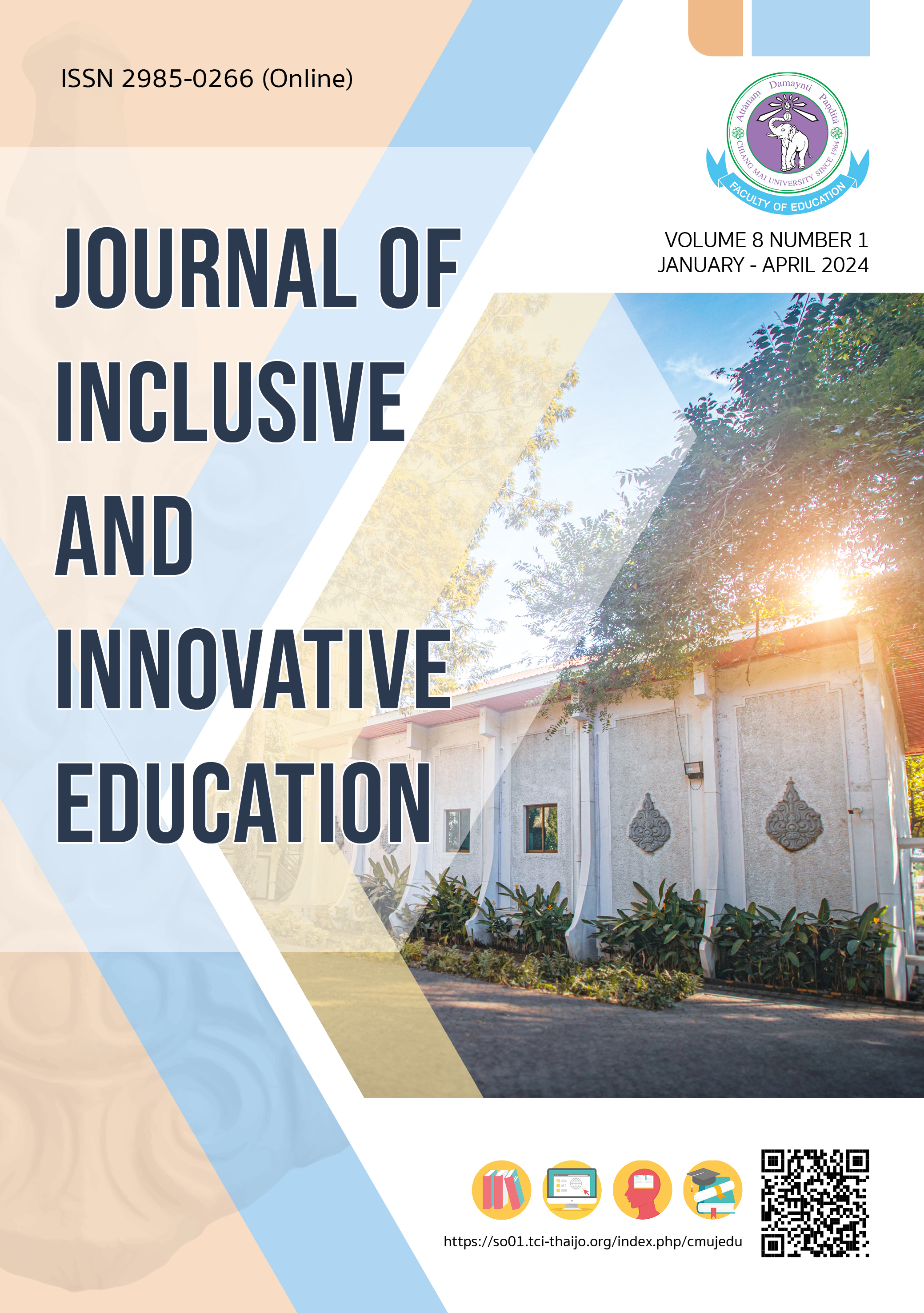Development of Self-Directed Learning Measurement Model for High School Students in Sekong Province, Lao People's Democratic Republic: A Confirmatory Composite Analysis
Main Article Content
Abstract
This research aims to develop and validate a measurement model of self-directed learning for high school students in the secondary education level (Grades 5 to 7) in the Sekong province, Lao People's Democratic Republic (Lao PDR). The study, conducted in the first semester of the academic year 2022, sampled 635 students from 7 schools using stratified random sampling. Data collection involved a 5-level Likert scale questionnaire with 48 items. Data analysis utilized Confirmatory Composite Analysis (CCA) with a Formative-Formative, Disjoint Two-stage Approach. The results of the study were as follow revealed that the self-directed learning measurement model comprises 8 components, namely: 1) Openness to learning opportunities, 2) Self-concept as an effective learner, 3) Independence learning, 4) Responsibility for one's own learning, 5) Love of learning, 6) Creativity, 7) Positive orientation to the future, and 8) Ability to use basic study skills and problem-solving skills. Each component consists of 2 indicators, totaling 16 indicators. The model demonstrated a good fit with the observational data.
Article Details

This work is licensed under a Creative Commons Attribution-NonCommercial-NoDerivatives 4.0 International License.
หากผู้เสนอบทความมีความจำเป็นเร่งด่วนในการตีพิมพ์โปรดส่งลงตีพิมพ์ในวารสารฉบับอื่นแทน โดยกองบรรณาธิการจะไม่รับบทความหากผู้เสนอบทความไม่ปฏิบัติตามเงื่อนไขและขั้นตอนที่กำหนดอย่างเคร่งครัด ข้อมูลของเนื้อหาในบทความถือเป็นลิขสิทธิ์ของ Journal of Inclusive and Innovative Education คณะศึกษาศาสตร์ มหาวิทยาลัยเชียงใหม่
References
Abd-El-Fattah, S. M. (2010). Garrison's model of self-directed learning: preliminary validation and relationship to academic achievement. The Spanish journal of psychology, 13(2), 586-596.
Areglado, R.J., Bradley, R.C., & Lane, P. (1996). Learning for Life: Creating Classrooms for self-directed Learning. California: Corwin Press.
Candy, P. C. (1991). Self-Direction for Lifelong Learning. A Comprehensive Guide to Theory and Practice. Jossey-Bass, 350 Sansome Street, San Francisco, CA 94104-1310.
Chianchana, C. (2016). Developing of the measurement Model of self-directed learning characteristics. European Proceedings of Social and Behavioural Sciences, 8, 1-17.
Chinnapong, U., & Phunsuwan, S. (2012). The Development of Self-Directed Learning Model for Community College Students. Journal of Research and Curriculum Development, 18(2), 53-67. [in Thai]
Christie, D., & Viner, R. (2005). Adolescent development. Bmj, 330(7486), 301-304.
du Toit-Brits, C., & van Zyl, C. M. (2017). Self-directed learning characteristics: making learning personal, empowering and successful. Africa Education Review, 14(3-4), 122-141.
Gudmundsson, E. (2009). Guidelines for translating and adapting psychological instruments. Nordic Psychology, 61(2), 29-45.
Guglielmino, L. M. (1977). Development of the self-directed learning readiness scale. Georgia: University of Georgia.
Fufueang, T. (2019). A study of Self-Directed Learning readiness of nursing students in Pathumthani university. Journal of Suvarnabhumi Institute of Technology (Humanities and Social Sciences), 5(2), 551-560. [in Thai]
Hair, J. F., Ringle, C. M., & Sarstedt, M. (2011). PLS-SEM: Indeed a silver bullet. Journal of Marketing Theory and Practice, 19(2), 139-152.
Hiemstra, R. (1994). Self-Directed Learning. In T. Husen and T. N. Postlethwaite. The International Encyclopedia of Education. Oxford: Pergamon Press.
Khamin, P. (2017). Developing self-directed teaching to promote integrated learning in performing arts subjects. Humanities Research Journal, Chiang Mai Rajabhat University, 13(1), 99-116. [in Thai]
Knogmang, J., Skulkhu, J., Wattananarong, A. (2013). Self-directed learning characteristics of business administration students at faculty of business administration Ramkhahaeng university. Journal of Srinakharinwirot Research and Development (Journal of Humanities and Social Sciences), 5(9), 16-33. [in Thai]
Knowles, M. S. (1975). Self-directed learning: A guide for learning and teachers. Englewood Cliffs, NJ: Prentice Hall.
Leung, C., & Chan, T. W. (2018). The effects of self-directed learning on creativity in problem solving: A study of undergraduate students in Hong Kong. Thinking Skills and Creativity, 26, 1-12.
Liu, X., Wang, H., & Chang, C. H. (2019). The effects of self-directed learning on students' happiness and life satisfaction: A meta-analysis. Journal of Happiness Studies, 20(4), 1097-1114.
Ruchan, U. Z., & Adem, U. Z. U. N. (2018). The influence of blended learning environment on self-regulated and self-directed learning skills of learners. European journal of educational research, 7(4), 877-886.
Sawatsky, A. P., Ratelle, J. T., Bonnes, S. L., Egginton, J. S., & Beckman, T. J. (2017). A model of self-directed learning in internal medicine residency: a qualitative study using grounded theory. BMC medical education, 17, 1-9.
Schuberth, F., Henseler, J., & Dijkstra, T. K. (2018). Confirmatory composite analysis. Frontiers in Psychology, 9, 2541.
Skager, R. W. (1978). Lift long education practice. Hamburg. UNESCO Institute for Education.
Soper, D.S. (2023). A-priori Sample Size Calculator for Structural Equation Models [Software]. Retrieved from https://www.danielsoper.com/statcalc.
Sripramai, S., & Sivabaedya, S. (2013). Factors Affecting Students’ Self-Directed Learning. Journal of Education Khon Kaen University (Graduate Studies Research), 7(2), 183-196. [in Thai]
Srirat, P. (2011). Causal Factors Influencing Self-Directed Learning among Fourth-Year Secondary School Students in Nong Bua Lamphu Province (Research report). Mahasarakham: Mahasarakham University. [in Thai]
Steinberg, L., & Morris, A. S. (2001). Adolescent development. Annual review of psychology, 52(1), 83-110.
Tan, L., & Koh, J. (2014). Self-directed learning: Learning in the 21st century education. Educational Technology Division, Ministry of Education.
Thomas, H. M. (2019). Self directed learning: A fundamental competence in a rapidly changing world. International Review of Education, 65, 633-653.
Toit-Britset, E., Van der Walt, C., & Vorster, J. (2017). The role of self-directed learning in the 21st century: A theoretical framework and empirical evidence. South African Journal of Education, 37(2), 1-17.
Westland, J.C. (2010). Lower bounds on sample size in structural equation modeling. Electronic Commerce Research and Applications, 9(6), 476-487.
Wong, F. M. F., Tang, A. C. Y., & Cheng, W. L. S. (2021). Factors associated with self-directed learning among undergraduate nursing students: A systematic review. Nurse education today, 104, 104998.
Yang, C., Zhu, Y., Jiang, H., & Qu, B. (2021). Influencing factors of self-directed learning abilities of medical students of mainland China: a cross-SELtional study. BMJ open, 11(10), e051590.
Yamsang, W. (2014). A Study of a Self-Directed Learning Readiness of Ramkhamhaeng University Students. [in Thai]


